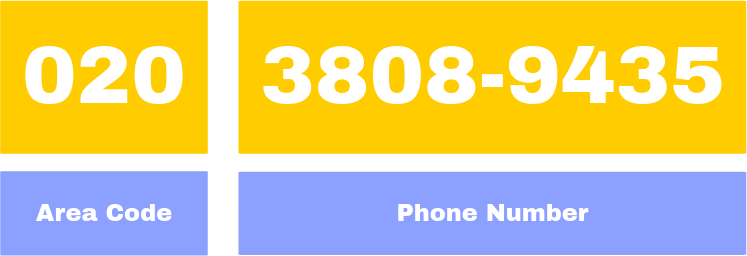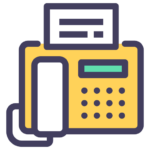While many of us rely on emails and instant messaging platforms, the use of fax remains prominent in several business industries. Understanding how to format a fax, including the fax number and cover page, is an important skill to have. In this article, we’ll shed light on the format of a fax number, how to format a fax cover page, and the file format for a fax.
What is the format of a fax number?
When you think about fax numbers, you should know they are identical to phone numbers, and follow a specific format. Here’s how they break down in local, national, and international terms.
Local format (within your city)
Locally, the fax number format is straightforward. If you are sending a fax within the same area code, you only need to use the local number. For instance, in the US, if the full number is 212-555-1234, you would simply dial 555-1234.
National format (within your country)
In the U.S., if you’re sending a fax to a different area code, you need to include the U.S. long distance prefix ‘1‘, followed by the area code and the local number. So, for the number in Alaska, you’d dial 1-907-555-1234.
In other countries, the long distance prefix is usually ‘0‘, so to fax from Paris to Lyon you would dial 04 2345 6789.

International format

For international faxing, you need to know the international access code, which is ‘011‘ in the U.S. and ‘00‘ in most other countries, then the country code, the area code, and the local number. For instance,
- If you’re faxing from the U.S. to London, UK, you would dial:
011-44-20-1234567, whereas - If you’re faxing from the UK to New York, you would dial:
001-212-555-1234.
You might see this displayed as ‘+44-20-1234567’ or ‘+1-212-555-1234’, where the ‘+‘ sign serves as a generic international access code and means “precede the number with whatever your international access code is”.

Can a fax number be 7 digits (or 6, or 8, etc.)?
Sometimes.
A fax number can be 7 digits long, especially when you’re dialing within the same local area or city. In such instances, you do not typically need to dial the area code, which makes the effective dialing number 7 digits. This holds true in certain areas where the telecommunications infrastructure supports 7-digit dialing, such as in some regions in the United States and Canada.
However, for broader or international communications, fax numbers will require an area code or a country code, respectively, making the total number of digits more than 7.
In the US, do I need to add a ‘1’ before dialing a fax number?
In the US, you only need to add the ‘1’ before dialing a fax number if you’re sending a fax to a different area code.
The ‘1’ serves as the long distance prefix. So, if you’re in New York (area code 212) and you’re sending a fax to Los Angeles (area code 323), you would dial 1, then the area code, and then the local number, like:
1-323-555-1234.
However, if you are sending a fax to a number within the same area code as you, you do not need to add the ‘1’. You can simply dial the local number. For instance, if you’re faxing to another number in New York City, you would just dial the local number 555-1234.
Can any random number be a fax number?
No, a random phone number will not necessarily serve as a fax number. There are some criteria that a number must meet to be a valid fax number:
- Length of the number: The length of the number should conform to the local telecommunications regulations. For instance, in the United States, a fax number without the country code typically includes an area code and a 7-digit local number, for a total of 10 digits.
- Assignment and activation: A number must be assigned by a telecommunications provider and activated as a phone line.
- Proper formatting: Fax numbers must also adhere to the proper format, which usually includes a country code (for international faxes), an area code, and a local number.
- Availability: The number cannot already be in use as a phone line unless it is specifically set up to handle both voice calls and faxes, which some modern systems can handle.
In essence, while a random number could potentially be a fax number, it would have to meet these criteria. Simply choosing a random number and attempting to send a fax to it is unlikely to be successful unless that number is a valid, active fax line.
How to format a fax cover sheet
The cover page is a useful addition to your fax because it contains information about how to route the document you’re sending. Here’s what a standard fax format includes:
- Your contact information: Your name, company name, and fax number.
- Recipient’s information: The recipient’s name, company name, and fax number.
- Date: The date you are sending the fax.
- Number of pages: The total number of pages including the cover sheet.
- Subject line: A brief explanation of what the fax pertains to.
- Additional notes: Any extra information or instructions that the recipient should be aware of.
The cover page helps to ensure your fax reaches the correct recipient and provides a quick overview of what to expect in the subsequent pages.
What is the file format for a fax?
Traditional fax machines operate by transmitting data via a phone line, scanning the document and converting it into a bitmap image. This bitmap is then sent through the phone line where the receiving fax machine will print the bitmap image.
TIFF Group 3 (.tif)
The most common file format is TIFF (Tagged Image File Format) because of its high quality and excellent compatibility with fax machines. However, the variant of TIFF often used in faxing is known as TIFF Group 3 or TIFF G3.
TIFF G3 is a monochrome (black and white) image format. It uses a compression technique that is very efficient for documents containing mostly text. One notable feature of this format is its ability to store multiple pages within a single TIFF file, making it ideal for multi-page faxes. Because of these advantages, the TIFF G3 format has become a standard in the world of faxing, both for traditional and digital faxes.
PDF is also great
While the TIFF G3 format is a standard in traditional faxing, the Portable Document Format (PDF) has become a popular choice for online fax services. PDFs maintain the formatting and layout of a document regardless of the device or software used to open them, making them ideal for online faxing.
The PDF format is universally compatible and is designed to preserve the original appearance of a document, including its page size, fonts, images, and layout. This is especially valuable in a professional setting where it’s crucial to maintain the clarity and integrity of documents being transmitted.
But others, too
Now in the modern era of digital or internet faxing, fax services have expanded their file format acceptability. Now, alongside TIFF and PDF, formats such as DOC, DOCX, JPG, and PNG are also accepted. These digital files are usually converted into a fax-compatible format like TIFF G3 in the background by the service.
